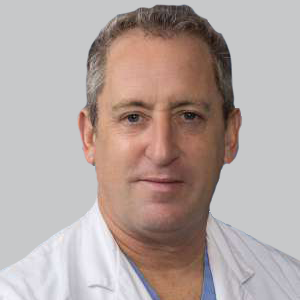Article
Gene Therapy Shows Promise for Parkinson Disease
Author(s):
VY-AADC01 demonstrated promising early signs of activity and safety for patients with Parkinson disease.
Chadwick W. Christine, MD, PhD, from the University of California, San Francisco

Chadwick W. Christine, MD, PhD
Magnetic resonance imaging (MRI)-guided putaminal administration of a novel gene therapy encoding the AADC gene demonstrated promising early signs of activity and safety in a multi-dose, phase 1b clinical trial for patients with Parkinson disease, according to findings presented at the 2018 ANA Annual Meeting.1
The therapy, VY-AADC01, uses adeno-associated viral vector serotype 2 (AAV2) to encode the AADC gene, which is involved conversion of levodopa to dopamine. Twelve months following infusion of VY-AADC01, there was a 14% to 32% increase in on-time without troublesome dyskinesia across all doses administered. Additionally, there was a 40% to 60% decrease in on-time with troublesome dyskinesia and an 11% to 53% decline in off-time. Adding to this, there were no signs of serious adverse events reported in the study.
"The time spent on and on without troublesome dyskinesia increases over the duration of the observation of the cohorts, suggesting improvement in the on-time," Chadwick W. Christine, MD, PhD, from the University of California, San Francisco, said during his presentation at the meeting. "This study so far has shown safety and signals of possible clinical benefit."
The phase Ib study enrolled 15 patients across 3 dosing cohorts. Across the cohorts, VY-AADC01 was administered at 7.5 x 1011 vg (n = 5; cohort 1), 1.5 x 1012 vg (n = 5; cohort 2), and 4.7 x 1012 vg (n = 5; cohort 3). Intraoperative MRI was used to guide infusions of the gene therapy, an showed 21% putaminal coverage for the cohort 1 dose, 34% in cohort 2, and 42% in cohort 3.
"You can see improvement as each cohort is done, which reflects both greater volumes between cohort 1 and 2 and greater surgical improvements between cohorts 2 and 3," said Christine.
The average age of patients was 58 years and the average time from diagnosis of Parkinson disease was 10 years. Across cohorts, patients recorded an average of 4.6 hours of off-time per day. The mean Unified Parkinson's Disease Rating Scale-III (UPDRS-III) was 19.2 for cohort 1, 17.4 for cohort 2, and 30.2 for cohort 3, representing a significantly higher severity of dyskinesia. Across all cohorts at baseline, patients were receiving an average of 1526 mg of oral levodopa per day.
Following infusion of the gene therapy, marked increases in AADC activity, as measured by DOPA-PET, were noted across each cohort, which highly correlated (P = .0002) with daily reductions in levodopa equivalent doses (LEDs) at 6 months. In cohort 1, AADC activity increased by 13%, which led to a drop of 14% in daily LED (-208 mg). In cohort 2 and 3, AADC activity increased by 56% and 79%, respectively, leading to a drop in LED of 34% (-553 mg) and 42% (-618 mg).
At 6 months, the UPDRS III off-medication score dropped by 15.6 points in cohort 1 and by 17.8 and 13.6 in cohorts 2 and 3, respectively. Those on medication had a 1.6 score increase in cohort 1 and a decline in UPDRS III score of 8.6 and 9.6 in cohort 2 and 3, respectively. At 6 months post infusion of VY-AADC01, the time to 30% change in UPDRS III score was significantly reduced for threshold and superthreshold doses of intravenous (IV) levodopa, showing greater sensitivity to the therapy. Moreover, the duration of the change was greater following administration of the gene therapy.2
In cohort 1, the baseline average off-time hours was 4.9 hours. By 24 months post-infusion, this declined to 3.1 hours and by month 36 it was 3.5 hours. The amount of on-time without dyskinesia in this cohort was 5.1 average hours at baseline, which improved to 7.0 hours at month 24 and 9.7 hours at 36 months.
Similar declines in off-time were seen in cohort 2, with a drop from 4.2 hours at baseline to 2.3 hours at 24 months post-infusion of VY-AADC01. On-time without dyskinesia was 5.8 hours at baseline and 7.3 hours at month 24. Data were not yet available for the 36-month analysis in this cohort. In cohort 3, wherein patients had the most severe levels of dyskinesia, off-time declined from 4.7 hours at baseline to 4.1 hours at month 12. Diary on-time without dyskinesia improved from 8.1 hours at baseline to 9.8 hours at month 12.
There were no vector-related serious adverse events reported in the trial, Christine noted. One patient experienced a pulmonary embolus and atrial fibrillation that was related to the surgical procedure. Deep vein thrombosis prevention was subsequently included during the surgical procedure. This adverse event fully resolved with anticoagulation therapy. Transient gene therapy-related dyskinesia was reported for 4 patients.
Quality of life was measured using a variety of questionnaires. By the PDG-39 measure at month 12, there was a mean improvement from baseline of 8.4 points with VY-AADC01 in cohort 2 and an improvement of 9.1 points in cohort 3. There was not a meaningful improvement in quality of life in the cohort 1 (0.9-point change).
“Though the patient numbers are small and further, larger trials are required, this study provides highly encouraging support for the potential of gene therapy in Parkinson's disease,” said M. Elizabeth Ross, MD, PhD; director, Center for Neurogenetics at Weill Cornell Medicine and Chair of the ANA’s Scientific Program Advisory Committee, commented in a press release.
A phase 2 study is currently enrolling patients to explore VY-AADC02 in patients with Parkinson disease and motor fluctuations. The trial plans to enrolled 42 total patients with randomization to the gene therapy at a single dose of up to 2.5 x 1012 vectors or a placebo (sham surgery). The primary endpoint of the trial is changes in patient related motor fluctuations. The estimated completion date for the study is December 2020 (NCT03562494).
References:
- Christine CW, Larson PS, Van Laar AD, et al. VY-AADC01 in Medically Refractory Parkinson’s Disease: Safety and Efficacy of a Phase 1b Dose-ranging Study 12 Months and Beyond. Presented at: 143rd American Neurological Association Annual Meeting; Atlanta, Georgia, October 21 to 23, 2018. Abstract M300.
- Nutt J, Curtis C, Christine CW, et al. AADC gene therapy (VY-AADC01) enhances responses to IV levodopa in Parkinson's disease. Presented at: 143rd American Neurological Association Annual Meeting; Atlanta, Georgia, October 21 to 23, 2018. Abstract M314.





